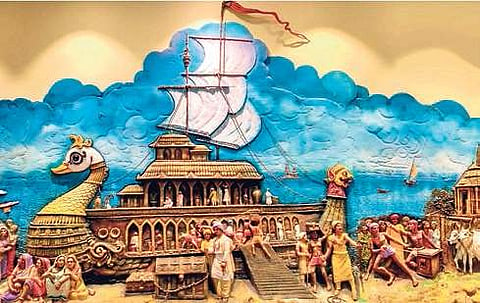

KENDRAPARA: Mariners of ancient Odisha were aware of monsoon winds and used them for timing their seafaring much before the discovery of the season and its behaviour by Greek navigator Hippalus between 45-47 AD.
Since more than 2000 years ago, traders of Odisha used to set sail to the Southeast Asian countries during the northeast monsoon and returned during the southwest monsoon, a new research has claimed.
“During my extensive research, I came to know that the traders of ancient Odisha were the first to use monsoon routes for their seafaring,” said Dr Sila Tripathi, a senior marine archaeologist with Marine Archaeology Center in National Institute of Oceanography, Goa.
During the early historical period, Buddhism played a significant role in maritime trade. Ancient Chinese traveller Fa-Hein, who had visited India during 399-414 AD to gather information on Buddhism, wrote the book Record of Buddhistic Kingdoms where he made an indirect reference to the northeast monsoon in connection with his voyage along the east coast of India, Dr Tripathi elaborated.
The research based on recent archeological finds from ports and trade centres show the existence of a well organised overseas network connecting Southeast Asia, Red Sea and Roman world. The voyage to Southeast Asia was seasonal and coast hugging because ships were visiting different ports during their voyage and exchanging cargo.
“The maritime trade from India to Southeast Asia was a seasonal phenomenon. Our study shows that there have been no changes in seasons of monsoon over the past 2000 years except in their intensity and velocity,” he added.
Odisha mariners were aware of monsoon before its discovery
The distribution of Buddhist settlements, discovery of varieties of pottery, beads and inscriptions along the ports and trade centres dating before the first recorded discovery of the monsoon point to active maritime trade between India and Southeast Asia. Mariners used to exchange their cargo at various ports and sail to their destination along with local sailors with the help of monsoon winds and currents.
Sunil Patnaik, secretary of Orissan Institute of Maritime and South East Asian Studies (OIMSEAS), said, “The coastal people and marine fishermen have traditional knowledge about the weather prediction. The vast knowledge has been passed down the generations through word of mouth. Buddhist monks also knew about the arrival of monsoon and wind for which they built many caves and monasteries to reside for four months from June to September in these places. Sadhus and religious people also observe “Chatrumasi” (four months) period in hilly areas to avoid flood in the rainy season.”